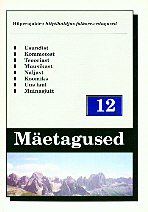Kakskümmend kaks kala eesti rahvausundis II
Twenty-Two Fish in the Estonian Folk Belief II
Author(s): Mall HiiemäeSubject(s): Customs / Folklore
Published by: Eesti Kirjandusmuuseum
Summary/Abstract: Ruff (Gymnocephalus cernuus) is a well-known freshwater fish in Estonia. The typology index of P. Kippar (1986: 166) introduces 256 narrative types of Estonian origin known locally, which mention a huge ruff, while M. Kuusi (1976: 311-313) argues that narratives concerning the huge ruff (AT 1960 B) figure only in the Finnish lore. As sprat (Sprattus sprattus balticus) became an important fishing article only in the late 19th century, it has no significant role in folk belief. The motif of a golden fish, who brings good fishing luck, is associated not just with the metal fish figures depicted in sacred chapels, but has common features with the pre-Christian fishing god. The embodiment of the golden fish in nature is either Baltic herring or some other fish. Bream (Abramis brama) is often mentioned in connection with the spawning season in spring, legends focus mainly on fishing (a supernatural protector of fish restrains the fisher; the haul is smaller because of people's greed). The origin of the name of minnow (Phoxinus phoxinus) (in Estonian: lepamaim, or leppkala) seems to lie in the reddish colour of the fish's lower side (in the archaic linguistic expression lepp carried the meaning of blood). The same name has been used to mark other smaller shoal fish. The unique shape of European flounder (Platichthys flesus) and turbot (Skophthalmus (Psetta) maximus) is explained in several myths of origin. The most popular explanation is that they originate from half-eaten fish. The reason why its mouth is crooked (it snaps at the God) is explained in the narratives from the western islands of Estonia. AT 250 A versions in the Estonian language are short and also refer to the flounder's outward appearance. The Livonians, who were the main competitors on the fishing waters, are known to have possessed the magic skills of relocating and "sweeping off" the flounders. Burbot (Lota lota) is caught by ice fishing during the spawning time, therefore it is connected to certain popular calendar days (e.g. the Twelfth Day on January 6, or St. Anthony's Day on January 17) in folk belief. Salmon (Salmo salar) as a predatory fish has a wide chin which swelling and curving on male fish during the mating season is particularly spectacular. An Estonian-Finnish-Karelian runo song describes the making of a mythic zither kannel (finnish kantele) - a local zithertype stringinstrument out of salmon chinbone. The Baltic four-horned sculpin (Triglopsis (Oncocottus) quadricornis quadricornis) has very conspicuous four spines on top of its head. Its resemblance to an ox or devil is reflected in the numerous popular terms. The unique appearance of the fish has inspired the negative attitude towards it. Unlike any other fish it has also earned a reputation of a fish created by a witch.
Journal: Mäetagused. Hüperajakiri
- Issue Year: 1999
- Issue No: 12
- Page Range: 7-29
- Page Count: 23
- Language: Estonian

